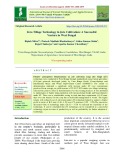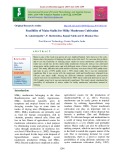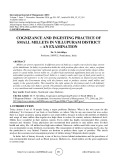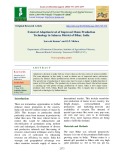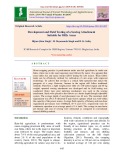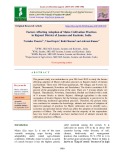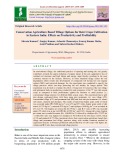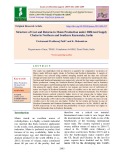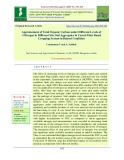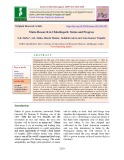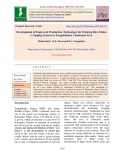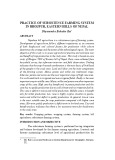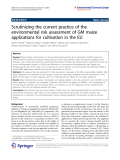
Maize cultivation practices
-
Farmers‟ participatory demonstrations on jute cultivation using zero tillage (ZT) technology were conducted in West Bengal through standardized conservation agriculture (CA)-jute protocols developed jointly by Uttar Banga Krishi Viswavidyalaya and International Maize and Wheat Improvement Centre (CIMMYT). The results of demonstration indicated a significant yield increase under ZT over conventional practices.On an average, an yield increase of 25.83-27.83% under zero tillage technology reflected the positive effect of demonstration over the existing practices.
 8p
8p  caygaocaolon6
caygaocaolon6
 30-07-2020
30-07-2020
 15
15
 1
1
 Download
Download
-
Maize is one of the food crop grown all over Andhra Pradesh. After harvest of the cobs, farmers have the practice of burning the stalks in the field itself. To overcome this problem and to test the feasibility of utilizing maize stalks for oyster mushroom cultivation this study was carried out. In this study milky mushroom (Calocybe indica) was cultivated using maize stalks, paddy straw and with different ratios of these two substrates for three years.
 6p
6p  nguaconbaynhay6
nguaconbaynhay6
 24-06-2020
24-06-2020
 15
15
 0
0
 Download
Download
-
Millets are grown expansively in different areas of India as a staple crop to feed a huge section of the inhabitants. In India, its production holds the sixth position after wheat, rice, maize, sorghum and bajra.
 7p
7p  guineverehuynh
guineverehuynh
 22-06-2020
22-06-2020
 6
6
 0
0
 Download
Download
-
Extent of adoption level of improved maize production technology in Saharsa district of Bihar, India
Adoption is decision to make full use of new ideas as the best course of action available. The term adoption, in this study is used to denote use of improved maize cultivation practices by farmers. Maize production has shown a tremendous increase in the country. The growth rate of production of maize since last five years is higher in India than that of maize in USA and China. The productivity of maize with more than 4 t/ha in Rabi season is catching up with global average productivity of maize. India is now major maize producer after USA, China, Brazil and Argentina.
 5p
5p  trinhthamhodang5
trinhthamhodang5
 16-05-2020
16-05-2020
 12
12
 0
0
 Download
Download
-
Mono-cropping practice is predominant under rain-fed agriculture in north east India, where rice is the most important crop followed by maize. It is apparent that areas under rice and maize remain fallow during the rabi season. These fallow lands can be effectively utilized for cultivation of rabi crops with improved technology. To achieve that sowing is a critical field operation that makes the prospects of a crop.
 8p
8p  caygaocaolon2
caygaocaolon2
 11-03-2020
11-03-2020
 10
10
 1
1
 Download
Download
-
The present study was undertaken in year 2014 and 2015 to study the factors affecting adoption of Maize cultivation practices in Rajouri district of Jammu and Kashmir. There were 160 Gram panchayats, 385 villages and 4 towns viz. Rajouri, Thanamandi, Nowshera and Sunderbani. The district constitutes 8.81 percent of the geographical area of the state. There are 7 revenue tehsils viz; Rajouri, Thanamandi, Nowshera, Sunderbani, Budhal and Darhal with a total of 9 revenue blocks in district Rajouri.
 7p
7p  caygaocaolon3
caygaocaolon3
 09-03-2020
09-03-2020
 9
9
 0
0
 Download
Download
-
In conventional tillage, the traditional practice of opening and turning the soil greatly contributes towards the quick oxidation of organic matter in the soil, quantitative loss of residual soil moisture and high labour and energy input thereby resulting in the poor economic returns for the farmers. However, in some situations tillage causes the soil degradation which results into development of compacted soil having low soil organic carbon (SOC) and restricted drainage.
 12p
12p  trinhthamhodang3
trinhthamhodang3
 14-02-2020
14-02-2020
 20
20
 0
0
 Download
Download
-
The study was undertaken with an objective to quantify the comparative economics of Maize, under different supply chains in Northern and Southern Karnataka. A sample of 240 farmers was selected using random sampling method and the data was collected through personal interview method. Tabular analysis was employed for analysing the data. Northern and Southern Karnataka were purposively selected for their major contribution to Maize production. Among the Northern districts, Belagavi and Haveri and in Southern districts Davangere and Chitradurga had the highest area and production.
 7p
7p  chauchaungayxua3
chauchaungayxua3
 07-02-2020
07-02-2020
 16
16
 0
0
 Download
Download
-
There has been a growing gap between the demand for maize and its supply. One of the reasons often attributed to decline in maize productivity is poor production practices, awareness and characterized by low use of modern inputs. In order to avoid the lack of all the above to assess the current levels of technical efficiency of maize cultivation like spacing of Maize cultivation with effective management of irrigation practices could be taken as a study.
 13p
13p  chauchaungayxua3
chauchaungayxua3
 07-02-2020
07-02-2020
 9
9
 0
0
 Download
Download
-
The effect of increasing levels of nitrogen on organic carbon and nutrient status under finger millet, maize and field bean, cultivated soil was studied in the experiment. Experiment was conducted at AICRPDA, under rainfed condition. Split plot design was used which consist of three levels of nitrogen viz., high (100% Recommended dose RD), medium (50% RD) and low (no application of nitrogen) as subplot and type of crop grown as finger millet, field bean and maize were grown as main plot under rainfed condition.
 14p
14p  nguaconbaynhay3
nguaconbaynhay3
 07-02-2020
07-02-2020
 21
21
 1
1
 Download
Download
-
Chhattisgarh, the 26th state of the Indian Union came into existence on November 1st, 2000. In Chhattisgarh, maize is a kharif season crop and second most important crop next to paddy in terms of both area and production. The state has got very good potential for maize but the productivity is very low due to cultivation of open pollinated varieties (OPVs) and improper input management practices. The real potential can be realized by the adoption of hybrid maize especially single cross hybrids with full package of practices.
 21p
21p  kethamoi2
kethamoi2
 14-12-2019
14-12-2019
 11
11
 1
1
 Download
Download
-
Traditional agricultural practices have resulted in decreased soil fertility, shortage of water resources and deterioration of agricultural ecological environment, which are seriously affecting production of maize. A field experiment was conducted in medium black soil during kharif and rabi season of 2016-17 and 2017-18 at farmer field near Agricultural Research Station, Sirguppa. The results revealed that, among improved production technologies of maize, higher grain yield were noticed with improved method-4 (T5: 7681 kg ha-1 ) over farmer method of cultivation (T1:5840 kg ha-1 ).
 8p
8p  cothumenhmong1
cothumenhmong1
 08-12-2019
08-12-2019
 11
11
 0
0
 Download
Download
-
Nepalese hill agriculture is a subsistence type of farming system. Development of agriculture follows different trajectories as an outcome of both biophysical and cultural factors for production while culture determines the strategy and the extent of the technological inputs. The main objective of this study is to assess agricultural practice and calculate cost and benefit of crop production in the study area. This study is based on case study of Bhojpur VDC of Eastern hill of Nepal. Data were collected from household survey, key informant interview and field observation.
 10p
10p  nguathienthan1
nguathienthan1
 27-11-2019
27-11-2019
 29
29
 1
1
 Download
Download
-
Tuyển tập các báo cáo nghiên cứu về hóa học được đăng trên tạp chí hóa hoc quốc tế đề tài : Scrutinizing the current practice of the environmental risk assessment of GM maize applications for cultivation in the EU
 15p
15p  sting03
sting03
 06-02-2012
06-02-2012
 42
42
 3
3
 Download
Download
CHỦ ĐỀ BẠN MUỐN TÌM









